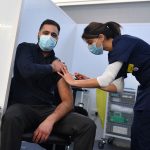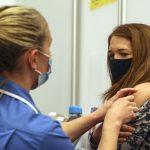England’s R number has risen slightly to between 0.8 and 1.1, the latest government figures show.
Last week, the R value – or reproduction number – was between 0.8 and 1.0.
The R number indicates the average number of people each COVID-positive person goes on to infect.
An R value between 0.8 and 1.1 means that, on average, every 10 people with the virus will go on to infect between eight and 11 other people.
The latest figures also show England’s COVID daily growth rate at -3% to +1%. It had previously been at -3% to -1%.
The prevalence of COVID-19 infections has increased to around one in 85 people – about 658,800 people – in private households in England for the week ending 25 September, the latest Office for National Statistics (ONS) data found.
Children have led the surge in infections, with more than one in 25 testing positive a month after schools reopened.
COVID-19: Wetherspoons suffers record loss as counts cost of lockdowns
COVID-19: NHS tests and scans in shopping centres and football stadiums to deal with backlog caused by pandemic
Butcher shortage causes backlog of 120,000 pigs that ‘should have been slaughtered and eaten by now’
In Wales, around one in 55 people is estimated to have had COVID in the same week – up from one in 60 the previous week and the highest week since the seven days to 23 December 2020.
Northern Ireland saw one in 65 people infected that week, down from one in 60 the week before.
For Scotland, the ONS estimates around one in 55 people had COVID that week, down from one in 45 the previous week, which had been the highest level since estimates began for Scotland in October 2020.






















